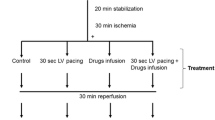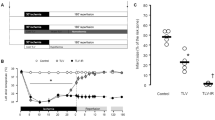Summary
Reperfusion of an isolated heart with a calcium-containing solution after a short calcium-free perfusion may result in irreversible cell damage: the calcium paradox. In this investigation the effect of hypothermia during reperfusion with calcium-containing solution on the calcium paradox damage in the isolated rat heart was studied. In addition, the effect of pre-cooling the heart during the calcium-free period was investigated. Creatine kinase release was used to define cell damage. Normothermic (37°C) calcium-free perfusion followed by normothermic reperfusion with calcium-containing solution resulted in a massive release of CK. When the normothermic calcium-free perfusion was followed by hypothermic (10°C) calcium-containing reperfusion, CK release was reduced by 20% (P<0.005). This CK release during reperfusion was further reduced by 55% and 80% when the normothermic calcium-free perfusion was followed by 5 or 10 min respectively of hypothermic calcium-free perfusion prior to the hypothermic calcium-containing reperfusion. The results show that hypothermia during the period of calcium repletion retards the sequence of events which ultimately results in release of large amounts of intracellular components.
Similar content being viewed by others
References
Baker JE, Bullock GR, Hearse DJ (1983) The temperature dependence of the calcium paradox: enzymatic, functional and morphological correlates of cellular injury. J Mol Cell Cardiol 15:393–411
Baker JE, Hearse DJ (1983) The temperature-sensitivity of slow channel calcium blockers in relation to their effect upon the calcium paradox. Eur Heart J 4 (Suppl H):97–103
Boink ABTJ, Ruigrok TJC, De Moes D, Maas AHJ, Zimmerman ANE (1980) The effect of hypothermia on the occurrence of the calcium paradox. Pflügers Arch 385:105–109
Bulkley BH, Nunnally RL, Hollis DP (1978) “Calcium paradox” and the effect of varied temperature on its development: a phosphorus nuclear magnetic resonance and morphologic study. Lab Invest 39:133–140
Ganote CE, Nayler WG (1985) Contracture and the calcium paradox. J Mol Cell Cardiol 17:733–745
Ganote CE, Sims MA (1984) Parallel temperature dependence of contracture-associated enzyme release due to anoxia, 2,4-dinitrophenol (DNP), or caffeine and the calcium paradox. Am J Pathol 116:94–106
Grinwald PM, Nayler WG (1981) Calcium entry in the calcium paradox. J Mol Cell Cardiol 13:867–880
Hearse DJ, Humphrey SM, Bullock GR (1978) The oxygen paradox and the calcium paradox: two facets of the same problem? J Mol Cell Cardiol 10:641–668
Holland CE, Olson RE (1975) Prevention by hypothermia of paradoxical calcium necrosis in cardiac muscle. J Mol Cell Cardiol 7:917–928
Hunt WG, Willis RJ (1985) Calcium exposure required for full expression of injury in the calcium paradox. Biochem Biophys Res Commun 126:901–904
Lamers JMJ, Stinis JT, Ruigrok TJC (1984) Biochemical properties of membranes isolated from calcium-depleted rabbit hearts. Circ Res 54:217–226
Nayler WG, Elz JS, Perry SE, Daly MJ (1983) The biochemistry of uncontrolled calcium entry. Eur Heart J 4 (Suppl H):29–41
Post JA, Nievelstein PFEM, Leunissen-Bijvelt J, Verkleij AJ, Ruigrok TJC (1985) Sarcolemmal disruption during the calcium paradox. J Mol Cell Cardiol 17:265–273
Rich TL, Langer GA (1982) Calcium depletion in rabbit myocardium: calcium paradox protection by hypothermia and cation substitution. Circ Res 51:131–141
Ruigrok TJC (1985) The calcium paradox and the heart. In: Parratt JR (ed) Control and Manipulation of Calcium Movement. Raven Press, New York, 341–365
Ruigrok TJC, Boink ABTJ, Spies F, Blok FJ, Maas AHJ, Zimmerman ANE (1978) Energy dependence of the calcium paradox. J Mol Cell Cardiol 10:991–1002
Ruigrok TJC, De Moes D, Borst C (1983) Bretschneider's histidine-buffered cardioplegic solution and the calcium paradox. J Thorac Cardiovasc Surg 86:412–417
Zimmerman ANE, Daems W, Hülsmann WC, Snijder J, Wisse E, Durrer D (1967) Morphological changes of heart muscle caused by successive perfusion with calcium-free and calcium-containing solutions (calcium paradox). Cardiovasc Res 1:201–209
Zimmerman ANE, Hülsmann WC (1966) Paradoxical influence of calcium ions on the permeability of the cell membranes of the isolated rat heart. Nature 211:646–647
Author information
Authors and Affiliations
Rights and permissions
About this article
Cite this article
Ruigrok, T.J.C., de Moes, D. & van der Meer, P. The effect of hypothermia during the period of calcium repletion on the calcium paradox. Basic Res Cardiol 81, 425–429 (1986). https://doi.org/10.1007/BF01907463
Received:
Issue Date:
DOI: https://doi.org/10.1007/BF01907463




